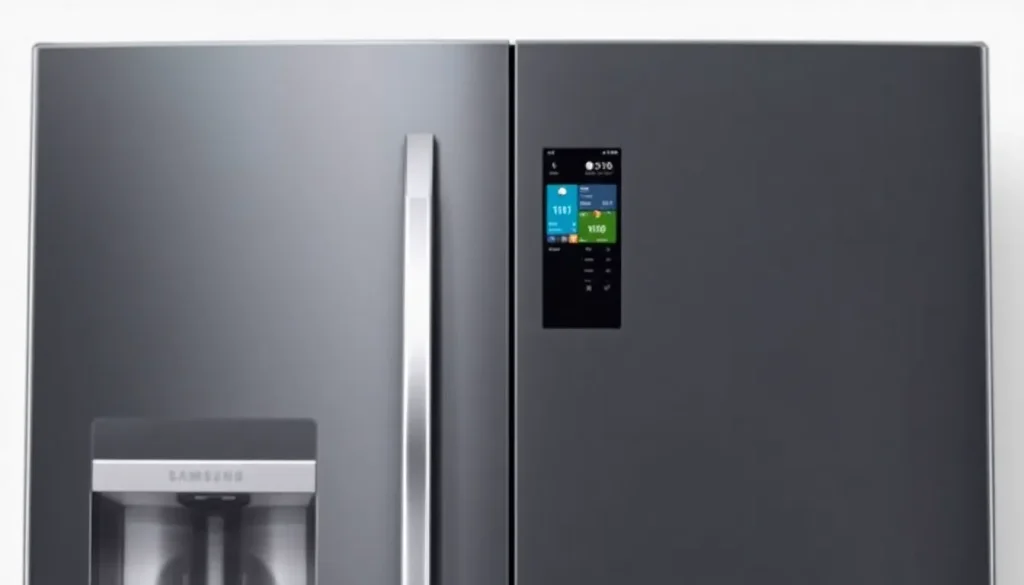Samsung fridge software update adds ads to high-end models

The integration of advertising in smart appliances has stirred a complex debate among consumers and technology enthusiasts alike. As more manufacturers introduce screens into everyday devices, the boundary between functionality and commercial messaging blurs. Samsung's recent software update for its premium refrigerators exemplifies this trend, raising questions about user experience and the future of smart home technology.
- The introduction of ads on Samsung's smart fridges
- Samsung's prior statements and the reality of the rollout
- Understanding the implications of smart appliance advertising
- How to avoid advertisements on smart fridges
- The ongoing challenge of smart appliance adoption
- The future of advertising in smart home devices
- Conclusion: Balancing innovation and user experience
The introduction of ads on Samsung's smart fridges
Recent reports have surfaced regarding a new software update for Samsung’s high-end refrigerators, which has led to the display of advertisements on their larger "Cover Screens." This change has been met with mixed reactions from consumers, particularly those who invested significantly in these appliances.
A message shared by users on platforms like Reddit revealed that these ads are presented to enhance user experience by providing additional content. The display read: "To enhance our service and offer additional content to users, advertisements will be displayed on the Cover Screen for the Weather, Color, and Daily Board Themes."
This shift has sparked concerns about the encroachment of advertising into personal spaces, especially in areas like the kitchen, where families gather and share meals.
Samsung's prior statements and the reality of the rollout
Remarkably, Samsung had previously downplayed the idea of incorporating ads into their appliance interfaces. In an interview with The Verge, Jeong Seung Moon, EVP and head of the R&D team for Samsung Electronics' Digital Appliances Business, stated that the company had "no plans regarding the inclusion of advertisements on AI Home screens." Yet, the current pilot program introduces ads, creating a dissonance between corporate messaging and consumer experience.
It’s important to note that the advertisements appear on the larger Cover Screens rather than the smaller AI Home Screens—an innovation Samsung rolled out in late 2024. This distinction may seem minor, but it highlights a potential lack of transparency in how Samsung communicates changes to its customers.
Understanding the implications of smart appliance advertising
Consumers who purchased smart refrigerators likely expected enhanced functionality rather than commercial messaging. The integration of screens in appliances has been marketed as a means to improve usability, but this latest update could lead to frustration among users who feel their privacy is compromised.
Moreover, many users may be unaware of the growing trend of using appliance screens for advertising, which stems from a larger industry shift towards monetization through user data and advertising revenue. Some may feel their expensive appliances are being transformed into "billboards" rather than tools for their convenience.
How to avoid advertisements on smart fridges
Based on Samsung's announcement, users can avoid seeing ads by displaying photos or artwork on their smart fridge screens. While this option exists, it restricts the functionality of the appliance and poses questions about the value of such a feature.
Another alternative for users who wish to eliminate ads entirely is to disconnect their fridges from the Internet. However, this action would also disable essential features such as:
- Meal planners
- Recipe suggestions
- Shopping list management
This dilemma illustrates the conflict between maintaining functionality and opting out of advertising. Furthermore, many smart appliance owners may not even notice the update, considering that a significant percentage of these devices remain offline. For instance, reports indicate that less than half of the smart appliances sold by LG were connected to the Internet in 2023.
The ongoing challenge of smart appliance adoption
Smart appliance manufacturers are on a quest to access valuable user data, which becomes increasingly challenging when consumers opt out of connecting their devices. Concerns about privacy, indifference towards smart technology, and technical limitations further complicate this landscape.
Samsung's recent experience serves as a reminder of how quickly tech companies can shift their focus towards monetization through advertising, turning once-simple appliances into platforms for commercial messaging. This trend raises broader implications about how companies prioritize revenue over user experience.
The future of advertising in smart home devices
As the trend of integrating advertisements into smart devices grows, it is likely that Samsung's pilot program will not be an isolated case. Many companies are increasingly relying on advertising revenue to sustain their business models, especially in light of the infrequency of large electronics purchases.
Trends indicate that as tech companies seek recurring revenue streams, we can anticipate:
- More ads displayed on smart appliances
- Lower prices on devices accompanied by increased advertising
- Heightened competition among brands to capture user attention through innovative ad strategies
This evolving landscape makes it essential for consumers to remain informed and proactive about the implications of smart technology in their homes.
To gain further insight into the growing concern over ads in smart appliances, check out this discussion on Reddit about consumer experiences with Samsung products:
Conclusion: Balancing innovation and user experience
The introduction of advertising on smart appliances illustrates the ongoing tension between innovation and user satisfaction. As technology continues to advance, it is crucial for manufacturers to prioritize transparency and user choice, ensuring that consumers feel empowered rather than exploited.
Ultimately, the future of smart home devices will hinge on how brands navigate these challenges, shaping the user experience in a landscape increasingly influenced by advertising.




Leave a Reply